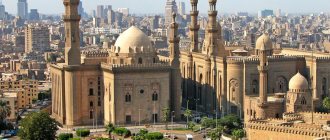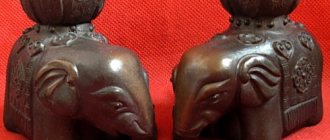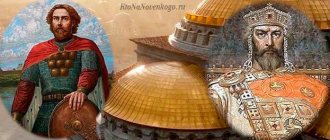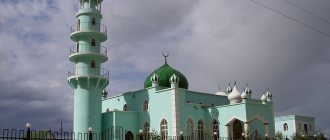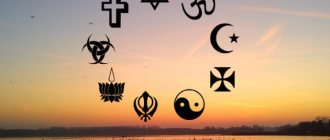Russian tradition: Orthodoxy or paganism?
“The Slavs need a new religion. There is too much modernism and civilization in Marxism. We can brighten up this side of Marxism by returning to our Slavic gods, whom Christianity deprived of their properties and their power, but which they will acquire again”[1], - these are not lines from a science fiction novel, these are real thoughts of Marshal of the Soviet Union M.N. Tukhachevsky. He also sent a note to the Council of People's Commissars with a proposal to declare paganism the state religion of the RSFSR... The Soviet leaders studied the red commander's proposal with interest, it was decided not to take such a radical step, but apparently they liked the idea of contrasting paganism with Orthodoxy, which was hated by the Bolsheviks. Indeed, throughout its seventy-year history, the formally atheistic Soviet state made unequivocal nods to ancient paganism.
Historically, the Russian nation was shaped by Orthodoxy, and Russian folk culture was deeply Christian in its essence. However, Soviet leaders viewed Russia only as a springboard for the subsequent world revolution, and the Russian people as a substrate for a new non-national “Soviet society.”
Russian folk culture was deeply Christian in its essence
Orthodoxy and national culture interfered with these global plans, and, therefore, were condemned. Therefore, the interest in paganism on the part of Soviet leaders, which was seen as a natural ally in the fight against Orthodoxy, is understandable. Crude atheistic propaganda in the spirit of newspapers like “Bezbozhnik” was suitable only for a very primitive public; the bulk of the population, most of whom were the peasantry, was quite religious and reacted poorly to standard atheistic propaganda. It was the peasantry, as the main bearer of the traditional folk way of life, that suffered the main blow. In addition to dispossession, collective farms and other economic measures of enslavement, steps were taken to change folk culture. Such a phenomenon as “amateur folk art” began to be actively introduced, which in essence represented the author’s processing of folk folklore, carried out by Soviet specialists. Folk songs and dances were subject to widespread unification. The original folk costume was essentially destroyed, replaced by satin sundresses with vulgar ornaments in flashy colors and awkward kokoshniks. Modern ethnographers, bit by bit restoring what was lost, call this synthesis of Russian-Soviet folklore “spreading Martian cranberries” for good reason.
However, the main goal of the Soviet ideological machine, designed to grind Russian culture, was folk holidays. According to the famous religious scholar Mircea Eliade, “a holiday is a period of direct contact between the sacred and secular sides of human existence. The holiday is a universal and most important feature of civilization, at the same time, the characteristics of the holidays reflect the differences between civilizations”[2]. Therefore, holidays are very important for national identity. Russian culture had a rich tradition of holidays, which were filled with images and allegorical symbolism, perfectly understandable to the people. The basis of the series of holidays were church memorial dates. Of course, the Soviet government did not want to put up with such blatant clericalism and invented all kinds of substitutions. So, Christmas became the New Year, Dormition became the day of harvest, Maslenitsa became the holiday of farewell to winter, etc. As a rule, everything connected with Christianity was removed from the basis of the holiday, but folk symbolism remained - devoid of its essence, it was no longer perceived as Christian, but, on the contrary, seemed like a kind of pagan echo that has survived to this day. It is these manifestations that are studied by secular specialists who are based on a materialistic worldview, while, as a rule, they have very little understanding of Christianity, finding paganism where it simply never existed. The Soviet academician B.A. succeeded most in this. Rybakov, who, without hesitation, simply took and attributed the entire folk culture to paganism. Then no one dared to object to the venerable academician, but today his works are subject to reasoned and objective criticism and are regarded as very weak.
It is worth noting that our ancestors were by no means ignorant in religious matters and understood perfectly well that it was impossible to glorify Christ and the pagan gods at the same time. Consider, for example, Maslenitsa, so beloved by our people.
Our ancestors understood perfectly well that it was impossible to glorify Christ and pagan gods at the same time
Maslenitsa is the last week before the Great, forty-day fast. On the one hand, this is a festive, riotous period, when it is still possible and even necessary to sing, dance, and have fun; on the other hand, it is preparation for fasting, and penitential chants are already heard at the service. Secular scientists see here only pagan festivals dedicated to the spring equinox, but an objective approach can reveal a completely different meaning of Maslenitsa. In the work “What does folk culture hide? Meanings and symbols of Maslenitsa” by TSU Associate Professor Ph.D. D.E. Krapchunov provides a detailed analysis of Maslenitsa paraphernalia and rituals and draws the following conclusion: “The analysis of Maslenitsa rituals, the identification of the mythology of the holiday through folklore texts and its calendar connection to Easter do not confirm the widespread idea of Maslenitsa as an exclusively pagan heritage. Despite the fact that the pan-Indo-European past can be traced in the traditions of Maslenitsa, there is every reason to see deep Christian meanings in this holiday, revealed through various verbal, visual and dramatic images”[3].
Maslenitsa, which appeared in Rus' with the adoption of Christianity, got its name - “white”, “cheese” or “Maslenitsa week”. However, the essence of the allegorical symbols of Maslenitsa is purely Christian. The Maslenitsa effigy in Christian culture is a symbol of human “decrepitness,” sinfulness, which burns up “like hay that touches fire.” “This fire, Lord, I don’t dare, hay, to touch the fire, lest you scorch my hay!” - an absolutely understandable Christian image, taken from the service of the Cathedral of John the Baptist. Sinfulness burns out, a person plunges into the days of Great Lent and is reborn to a new eternal life with the victorious cry of “Christ is Risen!” on the day of the bright holiday of Easter! The tradition of burning an effigy itself is not unique to the Christian world; for example, in Greece there is a tradition of burning an effigy of Judas.
Now that Soviet experiments are in the past, neo-pagan reinterpretations of Christian holidays are gaining popularity. Neopaganism is a fairly young pseudo-religious movement. This phenomenon has nothing to do with historical paganism. The Slavic peoples in the pre-Christian period did not have a written language; moreover, the religious tradition of the Indo-European peoples was traditionally transmitted orally. Therefore, information about Slavic paganism has survived to this day only in the form of apologetic notes by Christian chroniclers and missionaries, as well as Muslim travelers, that is, there are simply no authentic sources, and the very idea of reconstructing this long-gone religious tradition sounds absurd. A characteristic feature of neo-paganism is its pronounced anti-Christianity, and in connection with the interrupted tradition - superficiality and primitivism. For neo-pagans, the main task is to denigrate Orthodox Christianity, which they present as a phenomenon alien to Rus', which has never taken root in the popular consciousness. Neopagans actively exploit the folklore heritage; they publish a lot of amateurish articles in which attempts are made to find pagan traces in Russian holidays, or even simply declare them pagan. Unfortunately, even churchgoers, and sometimes even the clergy, accept such propaganda as truth. However, you should not be afraid of folk culture and do not trust it.
Christianity never adapted to culture, did not fight or destroy the traditions of peoples, it gradually transformed the consciousness of people, and they, in turn, created a new, spiritualized culture, imbued with true faith. And there is absolutely nothing wrong with the fact that in the tradition of Orthodox Japanese it is customary to take off your shoes before entering the temple, in the tradition of Orthodox Serbs it is customary to bring an oak log from the forest, which should burn in the hearth throughout the Christmas holidays, and in the tradition of Orthodox Russians it is customary to weave birch wreaths on Trinity or burning a straw effigy on Maslenitsa. These very different cultural characteristics reveal the same respect and gratitude to the Creator, who made it possible for people of all nations to be saved. It is important to know and understand the true meaning of folk traditions and try, if necessary, to explain it to those who are mistaken.
Who introduced Christianity to Rus'? How did it happen that pagan Rus' became an Orthodox country?
It is believed that Princess Olga was the first to convert to Christianity, having been baptized in Byzantium in about 957. For what reason she converted to Christianity remains a mystery. Nevertheless, according to the chronicles, among the warriors of Prince Igor (died in 945) there were many Christians, and in Kiev there was a Christian Church, where services were held and the oath was taken, “for many Varangians and Khazars” were Christians.
It can be assumed that in those days Rus' in the 9th-10th centuries was traditionally associated with Constantinople - Constantinople. These connections largely determined the orientation of Kievan Rus towards the Eastern Christian world.
But little by little Olga did her job, passionately wanting to introduce Christianity in Rus', and for this she began to persuade her son Svyatoslav to follow her path. But the prince was against Christianity.
Meanwhile, Prince Svyatoslav turned Kyiv into the center of Rus' and by the middle of the 10th century Rus' became a powerful state. This played an important role in the development of Christianity under the influence of Byzantium.
Coming to power after the death of Svyatoslav, Vladimir became king and decided to baptize Rus'.
Pagan consciousness
Many are sincerely surprised when they learn that Orthodoxy is Christianity. “Rus is baptized, but not enlightened” - the words attributed to Leskov do not lose their relevance. The low level of religious culture is a pressing problem for our country.
“Unenlightenment” is manifested in a peculiar attitude towards the rites and sacraments of the Church, in a specific understanding of “spirituality”. This phenomenon is not new: rare preachers were able to convey to the common people the essence of Christian teaching without distorting the meaning.
Christian elements fit comfortably into the pagan picture of the world, only slightly changing it. Magism and dual faith have always been characteristic of Russian religiosity: the acceptance of the ritual side of Orthodoxy with pagan consciousness.
Paganism puts a person in the position of a victim, because nothing depends on his moral efforts. There is no internal growth for him. Man lives between two worlds and is only a passive instrument of powerful “spirits” - evil or good. Therefore, the main task of a pagan is to find effective magical protection from evil “spirits” and please the good ones. For this there are special rituals that can only be performed by a dedicated priest. For a pagan, it is important that the ritual be performed correctly, since according to his picture of the world, only scrupulous execution of the ritual can bring success.
“Symptoms” of the manifestation of pagan consciousness in popular Orthodoxy
Pantheon of Gods . The saints, who are often addressed “instead of” God, have become completely self-sufficient “gods” in the pantheon of “popular Orthodoxy.” Hence the division of saints “by functionality”, by analogy with pagan deities: it is absolutely important to understand who to pray for what. Prayer to the “responsible saint” is considered more effective. Simply praying to God is incomprehensible and scary, and therefore ineffective.
"Shrines" . endowing objects with independent sacred value. All kinds of “shrines” are perceived as a source of “miracle”. Icons, relics, “land” and other attributes, which for Christians are only objects of reverent veneration, become in “folk Orthodoxy” a “magic wand” that can get rid of all troubles.
Again - regardless of your own efforts and Christ. It’s the same with notes, candles and prayers – actions and words that are incomprehensible to most are distorted and perceived as valuable “spells” in their own right (for example, the distorted 90th Psalm – popularly known as “Living Help”).
Ritualism . As it was said, for paganism, observing the ritual in small things was the key to success with the “higher powers.” In “folk Orthodoxy” this is expressed in observing the letter of the Church Charter without comprehension and faith.
At the same time, any deviations are categorically condemned. Hence the love of ceremonies (“Weddings are beautiful”), the frantic observance of everyday traditions (“On Easter, Easter cake and eggs must be blessed!”) and superstition (“You need to take communion so as not to get sick,” “Blessing your car to prevent accidents”).
The understanding of the relationship between God and man is completely distorted: personal, “filial” relationships (which is the essence of Christianity) are impossible here. Formal ones arise: instead of moral efforts and spiritual growth, there is pleasing the “god” through the fulfillment of certain external rules.
Baptism of Rus'
In the Tale of Bygone Years there is an episode called “The Tale of Vladimir’s Baptism”: in 986, envoys representing Eastern Christianity from Constantinople, missionaries from Rome, as well as representatives of Judaism and Islam came to Kiev. According to legend, Prince Vladimir liked the speech of the Greek preacher most of all, but he was still in no hurry to accept Christianity of the Eastern rite. The following year, the prince sent embassies to different countries so that they could become familiar with each of the religions on the spot. The chronicle says that the Latin and Muslim rites did not make much of an impression on the ambassadors, but Constantinople and the Greek church services delighted the ambassadors, and they began to strongly persuade Vladimir to accept Christianity of the Eastern rite. However, the final adoption of Christianity by Vladimir turned out to be connected with military-political circumstances - a campaign against Korsun and marriage to a Greek princess; The condition of the marriage was Vladimir's baptism. Returning to Kyiv in 988, Vladimir destroyed pagan temples and baptized the people in the Dnieper, after which he began to “build churches in the cities and appoint priests.”
To this day we are told that Vladimir is a bright personality and is now ranked as a Christian saint. But by nature he kept a harem, organized orgies, and even sacrificed Christians. The experience of a commander and the wisdom of a politician were combined in him with rage and unbridled cruelty. Drunken feasts were dedicated to Christian holidays.
There is an assumption that Vladimir was the son of a rabbi, i.e. he was not a Slav, a Russian, but was from a Khazar family. Thanks to Princess Olga, he became the son of Svyatoslav, i.e. Svyatoslav was Vladimir’s stepfather. Which is not uncommon in Rus'.
Subsequently, Vladimir actively contributed to the strengthening and spread of Christianity, and the year 988 was traditionally considered the official date of the baptism of Rus'.
